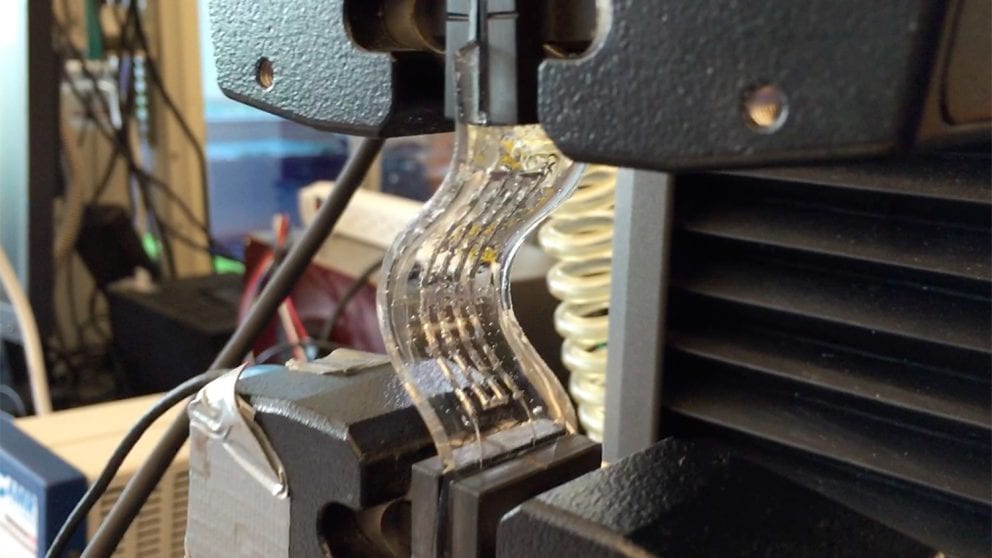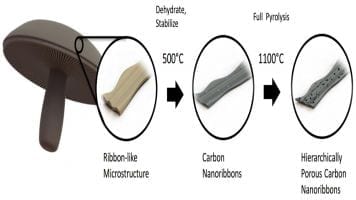
Using nanometer-scale components, researchers have demonstrated the first optical rectenna, a device that combines the functions of an antenna and a rectifier diode to convert light directly into DC current.
Potential to achieve 40 percent broad spectrum efficiency . . .
Based on multiwall carbon nanotubes and tiny rectifiers fabricated onto them, the optical rectennas could provide a new technology for photodetectors that would operate without the need for cooling, energy harvesters that would convert waste heat to electricity – and ultimately for a new way to efficiently capture solar energy.
In the new devices, developed by engineers at the Georgia Institute of Technology, the carbon nanotubes act as antennas to capture light from the sun or other sources. As the waves of light hit the nanotube antennas, they create an oscillating charge that moves through rectifier devices attached to them. The rectifiers switch on and off at record high petahertz speeds, creating a small direct current.
Billions of rectennas in an array can produce significant current, though the efficiency of the devices demonstrated so far remains below one percent. The researchers hope to boost that output through optimization techniques, and believe that a rectenna with commercial potential may be available within a year.
“We could ultimately make solar cells that are twice as efficient at a cost that is ten times lower, and that is to me an opportunity to change the world in a very big way” said Baratunde Cola, an associate professor in the George W. Woodruff School of Mechanical Engineering at Georgia Tech. “As a robust, high-temperature detector, these rectennas could be a completely disruptive technology if we can get to one percent efficiency. If we can get to higher efficiencies, we could apply it to energy conversion technologies and solar energy capture.”
The research, supported by the Defense Advanced Research Projects Agency (DARPA), the Space and Naval Warfare (SPAWAR) Systems Center and the Army Research Office (ARO), was reported September 28 in the journal Nature Nanotechnology.
Developed in the 1960s and 1970s, rectennas have operated at wavelengths as short as ten microns, but for more than 40 years researchers have been attempting to make devices at optical wavelengths. There were many challenges: making the antennas small enough to couple optical wavelengths, and fabricating a matching rectifier diode small enough and able to operate fast enough to capture the electromagnetic wave oscillations. But the potential of high efficiency and low cost kept scientists working on the technology.
“The physics and the scientific concepts have been out there,” said Cola. “Now was the perfect time to try some new things and make a device work, thanks to advances in fabrication technology.”
Read more: First Optical Rectenna – Combined Rectifier and Antenna – Converts Light to DC Current
The Latest on: Optical Rectenna
[google_news title=”” keyword=”Optical Rectenna” num_posts=”10″ blurb_length=”0″ show_thumb=”left”]
via Google News
The Latest on: Optical Rectenna
- Coaxial vs optical vs HDMI: which is the best audio connection to use?on May 5, 2024 at 10:22 pm
Allow us to present a brief overview. If you’ve ever owned a TV, DVD/Blu-ray player, set-top box, soundbar or AV receiver, chances are you’ll have come across either a coaxial, optical or, more ...
- Spring 2024 Commencement Speakerson April 30, 2024 at 4:09 pm
Five distinguished speakers will address Georgia Tech graduates during the upcoming Commencement ceremonies inside McCamish Pavilion.
- The Best Optical Gaming Keyboards in 2024on April 28, 2024 at 1:36 am
The best optical gaming keyboards are quickly becoming a popular choice among gamers, thanks to fewer moving parts to go wrong, and a shorter actuation distance (a fancy way of saying you can type ...
- Optical Illusion: Only Highly Intelligent People Can Spot The Scissors In This Image In 30 Secondson April 3, 2024 at 11:16 pm
Optical illusions aren't just fun puzzles. They're also great for keeping your brain healthy! These puzzles help kids get smarter by making them think in new ways. They learn to pay attention ...
- Optical Guitar Pickup Works With Nylon Stringson March 4, 2024 at 5:09 am
So what do you do? You follow [Simon]’s example, and build an optical pickup instead. The concept is simple. You place an LED and a phototransistor in a U-shaped channel, and place it so that ...
- Optical Coherence and Quantum Opticson October 20, 2023 at 9:18 am
Foley, John T. and Wolf, Emil 1995. Radiometry with Quasihomogeneous Sources. Journal of Modern Optics, Vol. 42, Issue. 4, p. 787. Azadeh, M. and Babbitt, W. R. 1996 ...
- Zenni Optical Coupons April 2024on October 2, 2022 at 10:28 pm
Use code and get 25% off selected products at Zenni Optical. Terms and conditions * Limited time only. * Selected items only. * Available while stock lasts. * Use the code to redeem the offer.
- Zenni Optical Coupons May 2024on October 2, 2022 at 5:00 pm
Thank you for browsing news.com.au Coupons on your exploration for reliable and verified Zenni Optical coupon codes... read more, alongside informative money-saving tips. Here at news.com.au ...
- 30 Optical Illusions That Will Make Your Brain Hurton July 22, 2021 at 5:00 pm
Before jumping on in we have one question on our minds: what is an optical illusion? What is an optical illusion? Optical illusions are visuals that tend to be deceptive to the eye and brain.
- optical clockon March 25, 2021 at 5:00 pm
But there is a move to replace that definition using optical clocks that are 100 times more accurate than a standard atomic clock. In recent news, the Boulder Atomic Clock Optical Network ...
via Bing News












